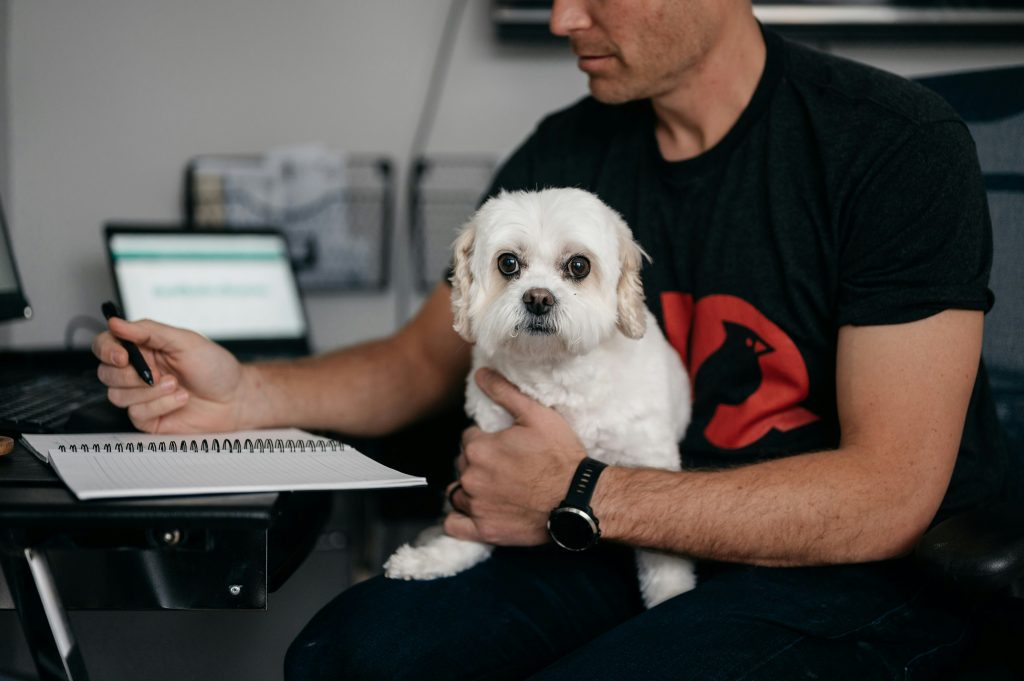Dogs Make Offices More Welcoming
When someone steps into a workplace for the first time—whether they’re a new hire, a client, or a guest—the environment speaks volumes before anyone says a word. Is the atmosphere cold and corporate, or warm and inviting? One way companies are shifting toward a more welcoming and inclusive culture is by embracing dogs in the workplace.
From the moment someone sees a happy pup lounging near a desk or greeting visitors at the door, the tone is instantly more friendly and human. Dogs help break down formality and make spaces feel safer, more personal, and far more approachable.
First Impressions Matter
Dogs change the energy of a space. Instead of sterile furniture and hushed tones, visitors are met with movement, curiosity, and a sense of life. A dog wagging its tail or curiously sniffing a newcomer helps ease anxiety and tension—especially for people who might feel nervous about meetings, interviews, or starting a new job.
This softens first impressions and helps people feel more at ease right away, setting the tone for more authentic conversations and stronger connections.
Creating a Human-Centered Culture
At its core, a dog-friendly workplace is a signal that the company values people as individuals, not just as workers. Allowing employees to bring their dogs says, “We understand life happens outside the office, and we want you to feel comfortable bringing your whole self to work.”
This message resonates strongly with today’s workforce, particularly younger generations who prioritize values like authenticity, flexibility, and emotional well-being in their work environments.
A Warmer Welcome for Clients and Guests
Dogs don’t just impact employees—they also enhance the guest experience. Whether you’re hosting a vendor, a client, or a partner, a friendly dog greeting them at the door can create a lasting, positive impression. It shows that your company culture is approachable, relaxed, and different from the average office.
Of course, it’s important to gauge your guests’ comfort levels—some people may have allergies or phobias. But for many, a well-behaved dog is a delightful surprise that makes your brand more memorable.
Lowering Social Barriers
Dogs have an amazing ability to level the playing field. In many offices, there’s a sense of hierarchy—managers eat separately, leadership seems unapproachable, and employees feel hesitant to speak up.
Dogs break down those barriers. When a company CEO is down on the floor petting a Labrador or tossing a ball with someone from IT, it sends a powerful message: we’re all people first. This helps flatten the hierarchy and encourage open, cross-level communication.
Supporting Diversity and Inclusion
While dogs themselves aren’t a DEI initiative, a dog-friendly policy can support broader inclusion efforts. When employees see their diverse needs—such as the desire to have a beloved pet nearby—being recognized and supported, it fosters a sense of belonging.
Moreover, dogs encourage empathy, care, and emotional connection, which are critical to inclusive workplace behavior. These subtle emotional cues contribute to a culture where people feel seen and valued.
Building a More Positive Workday
An office that allows dogs often feels less rigid and more balanced. Even during high-pressure periods, the atmosphere is lightened by the occasional bark, a wagging tail, or a dog rolling over for belly rubs. These small, joyful moments help employees feel less overwhelmed and more connected to their environment.
The ripple effect is powerful: happier employees are more welcoming to others, more patient during stressful situations, and more likely to contribute to a workplace that feels warm and safe.
Dogs Help During Transitions
For new hires, the first few weeks at a new job can be intimidating. Dogs ease the transition by acting as friendly, nonjudgmental companions during onboarding. New employees may feel more comfortable striking up conversations or stepping away for short breaks if they’re interacting with a dog.
For employees returning from time off, like parental leave or medical leave, the presence of dogs can help reduce reentry anxiety and foster a smoother reintegration into the workplace.
Tips to Keep the Office Welcoming for All
To maximize the positive impact of dogs while maintaining comfort for everyone, companies should consider the following best practices:
-
Get employee feedback: Not everyone loves dogs, so gauge interest and gather input before implementing a policy.
-
Offer dog-free zones: Create spaces for employees with allergies, sensitivities, or those who simply prefer to work without animals nearby.
-
Maintain cleanliness: Pet messes or odors can be a dealbreaker. Require that owners clean up after their pets and keep their areas tidy.
-
Ensure good behavior: Only allow dogs that are well-behaved, non-aggressive, and comfortable in social settings.
Final Thoughts
The best workplaces aren’t just about productivity—they’re about people. Creating a space that feels welcoming, inclusive, and emotionally warm goes a long way in supporting both business success and employee satisfaction.
Dogs play a surprisingly powerful role in shaping that kind of environment. They help everyone feel more at home, encourage genuine connection, and turn ordinary office settings into vibrant, human-centered spaces.
So, if your workplace could use a little more warmth and personality, don’t overlook the difference a four-legged friend can make.



